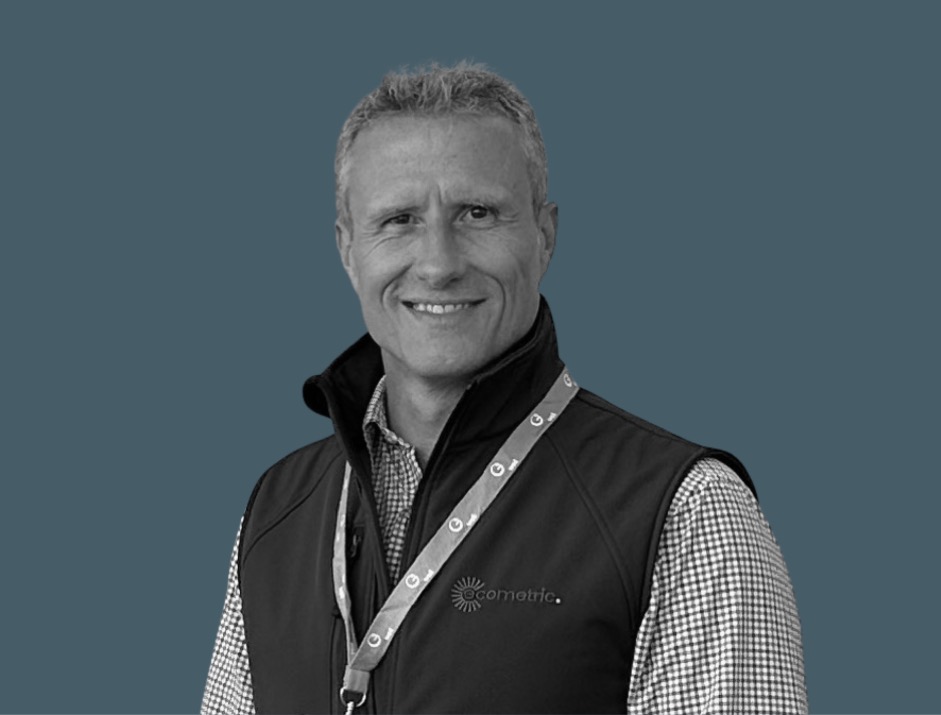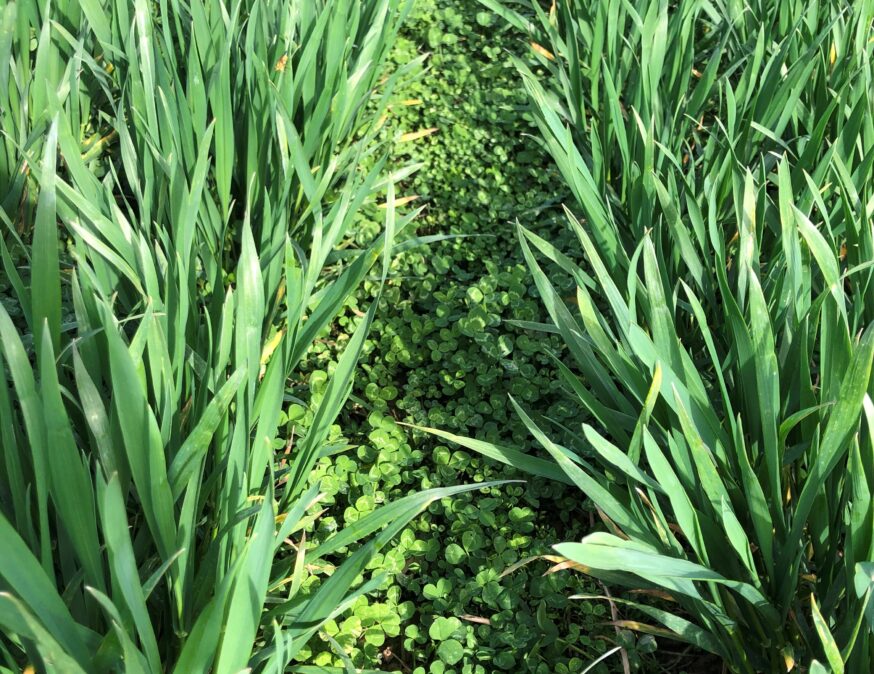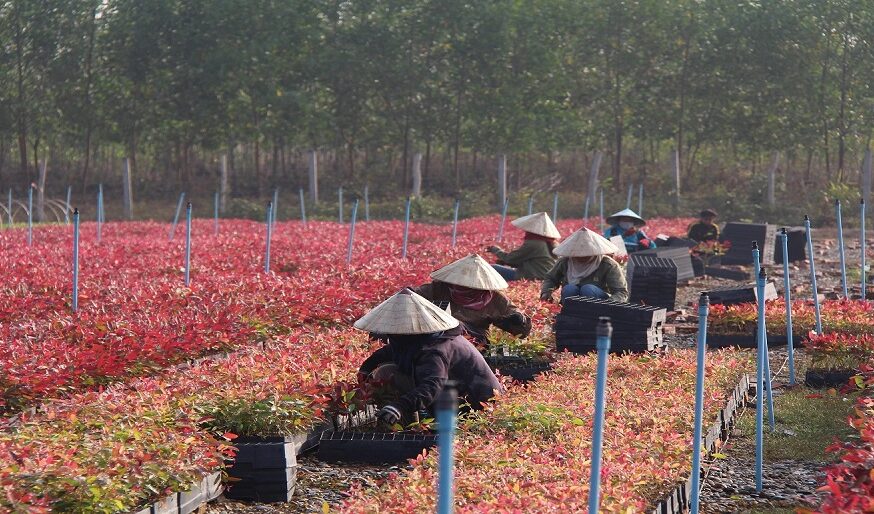When your passions are flying and farming, opportunities to combine your interests are, it’s fair to say, limited. Yet, David Wright has managed it. He has transitioned from Red Arrow Pilot, through Agri-tech CEO, and on to Climate-tech CEO. In 2021, David founded ecometric – a company combining physical and spectral sampling to reveal annual carbon changes in agricultural soil. Today, ecometric provides accurate data and evidence-based decision making support to farmers looking to explore regenerative agriculture while opening opportunities for carbon trading.
CAN YOU INTRODUCE YOURSELF AND EXPLAIN WHY YOU DECIDED TO FOUND ECOMETRIC?
The idea for ecometric stemmed, not from trading carbon, but as a means to draw focus of agriculture towards soil health. My previous Agri-tech company mapped crop canopy development from the air, which highlighted how yield was often dictated by limiting factors in the soil that couldn’t necessarily be corrected with chemical inputs. ecometric was set up to identify and monitor these key soil performance indicators to support improved management decisions. Soil organic carbon (SOC) was identified as one of the key indicators of system productivity and health, so we set about building a methodology to accurately monitor the SOC change associated with every production cycle.
The first stage was to design a soil sampling system that could account for a high degree of field-level SOC variability and to begin gathering data. The second stage was to introduce emerging AI technology that could relate spectral samples from multispectral satellite imagery to soil samples. This would increase the accuracy of quantifying SOC stock change. The third stage was to work with the farm management team to relate SOC change to specific, causal management decisions.
Rather than take a combative, disruptive approach, ecometric seeks to complement existing farming practices. We work for the farmer; we don’t work for the carbon market. Indeed, we sit completely outside of the transaction and make no money from the trading of carbon. This avoids conflict of interest and makes ecometric an extremely trustworthy farm management support tool.
COULD YOU SAY MORE ON THE PROBLEM YOU SEEK TO SOLVE?
A problem with conventional farming is the risk of SOC loss through oxidation, mineralisation, leaching and erosion. Such depletion of SOC stocks has many consequences, including making farmers increasingly reliant on artificial fertiliser to maintain yields. As the single biggest source of greenhouse gas emissions from the arable farming production system, the rising use of nitrogen fertiliser is exacerbating global warming.
A system change is needed to reverse this SOC decline. In moving towards regenerative practices, farmers can minimise soil disturbance, maximise the size and duration of crop roots and canopies and, where possible, reintroduce livestock or their manure into the rotation. The resulting increases in SOC levels are a reliable indicator of soil health, productivity and resilience against climatic extremes and, as we are beginning to evidence, increased farm business profitability.
ecometric is committed to creating a compelling, evidence-based case for regenerative agriculture. The concept of soil sampling is not new, it has been used for decades to assess the availability of nutrients and calculate fertiliser requirements! But at ecometric, we measure for the opposite reason. Our aim is to provide clear evidence that regenerative agriculture can sequester carbon from the atmosphere in contrast to the carbon emissions released from conventional systems. In doing so, we can directly relate increased organic carbon stocks to nitrogen requirement, yield, greenhouse gas emissions and business gross margin.
LET’S GET TECHNICAL: HOW DOES YOUR PRODUCT WORK?
There are three key components: the soil sample, the spectral sample and the Artificial Intelligence (AI). First, to directly measure soil organic carbon, we use the Dumas method. This measures and reports SOC and total nitrogen to a greater accuracy than alternative test types such as Loss on Ignition. As well as physical soil samples, we also source coincident spectral samples from multispectral satellite imagery.
Together, these measurements give us two, seemingly unrelated, sample types. To establish a relationship between the two datasets, we need a powerful computing system. This is where the AI comes in. We use an Artificial Neural Network (ANN) which is a technology constructed to work like a human brain. It learns iteratively from each dataset you give it, growingly progressively better with time and repetition.
The ecometric ANN is trained to relate the georeferenced soil sample results gathered at high density across the project area to the coincident spectral samples values. Once the system has established the site-specific relationship between the spectral and soil samples, it can accurately estimate SOC stocks from the multispectral imagery alone, reporting a discrete value for every 10-metre squared pixel. As the final test stage of this cycle, ANN results are directly compared back to the original soil sample results to calculate and report the average accuracy. With this method, ecometric has achieved repeatable accuracies of >95% over tens of thousands of hectares.
However, the process does not end when the ANN’s accuracy exceeds 90 percent. In line with the agricultural cycle, we take new samples every 12 months. And every 12 months, we retrain our models. As well as consistently improving the ANN, this means we have up-to-date physical results against which to check ANN accuracy. This tethers ANN estimations to on-the-ground realities and prevents the error rate increasing over time which is a common limitation of untethered models. Accuracy levels are ‘measurable’, and all sources of laboratory and AI error are treated as potential sources of over-estimation and deducted from the SOC stock totals.
Central to our methodology is the commitment to only trade climate positive, soil carbon gains. This means we deduct all the greenhouse gas emissions released during the farm’s production cycle and a landowner can only trade if there remains a surplus. This carbon balance report proves that the farm has added more carbon to the soil than has been emitted while growing food and fibre. The carbon revenue becomes a major incentive for farmers to adopt and improve regenerative methods that sequester enough carbon to generate a tradable surplus.
CAN YOU SHARE A STORY OF SUCCESS?
Within regenerative systems, we are evidencing an average annual SOC increase across the whole rotation and have correlated these findings to higher yields per hectare with lower quantities of nitrogen fertiliser. As an example, our highest performing project in 2022 yielded 11 tonnes of wheat using only 140 kg of nitrogen. To put that in perspective, the UK average for a crop that big, is 220 kg of nitrogen per hectare. This same farm also had the lowest greenhouse gas emissions of all benchmarked projects.
But it’s not just the nitrogen. When farmers exit the cycle of depletion, they unlock numerous additional benefits:
- Soil organic carbon holds water.
Every 0.5 percent increment in soil organic carbon stocks can hold another 150,000 litres of water per hectare. Therefore, by increasing the organic carbon content of soil, farmers are straight-away improving the resilience of that soil to droughts and dry spells. - There is a relatively fixed relationship between carbon and nitrogen in the soil.
As you increase the carbon, you also increase the naturally available nitrogen. This brings both environmental and economic benefits as yields can be consistently maintained while reducing quantities of applied nitrogen fertiliser. - More accurate reporting.
Many farmers use online carbon footprint calculators to estimate the emissions from their production systems. However, ecometric can provide more accurate insights by replacing the assumed sequestration values with a real-life measurement of soil carbon stock change. This is useful for supply chain reporting as supermarkets increasingly ask for environmental credentials to be displayed on a product’s packaging and accuracy is vital to optimising farm management decisions.
FINALLY, WHAT’S NEXT FOR ECOMETRIC?
To make the biggest, most positive climate impact, we need to operate over the largest possible area. Already working in ten countries (and with data share projects ongoing in another two) our priority is to scale internationally.
We are also digging deeper into our metrics to look beyond soil carbon and into other indicators of soil health. Soon, we will be looking at the bacterial and fungal loading of soil biomes with the aim of relating the soil carbon content with the biodiversity of the soil. From here, our ultimate aim is to relate these metrics to the nutritional value of the food coming out of the system. We have heard and seen much anecdotal and empirical evidence that food grown in regenerative systems is better for human consumption. So our next step is to prove this with data.
However, the central value of ecometric will always remain. We have balanced very carefully the need for accuracy from a carbon buyer perspective with affordability from a carbon seller perspective. At our core, we give land custodians the tools to measure improvements in soil health as a result of their changing land management practices. We don’t just give findings and walk away, ecometric is always part of the data interpretation and evidence-based action to support system change.
Disclaimer: ecometric works with one of Respira International’s flagship portfolio projects, Blaston Farm. Read more about ecometric here and about Blaston Farm here.
Share this article



